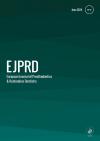European Journal of Prosthodontics and Restorative Dentistry
Effect of Particle Size and Application Pressure in Air-Borne Particle Abrasion on the Adhesion of Polyetheretherketone
Abstract
Introduction: This study aims to investigate the effect of different particle sizes and pressures on the shear bond strength (SBS) and the roughness (Ra) of polyetheretherketone. Materials and methods: A total of 117 polyetheretherketone specimens were fabricated and divided into a control (CN: no air-particle abrasion) and eight pre-treatment groups (air-abraded with 50- or 110-µm Al2O3 particles at 1(A), 1.5(B), 2(C), and 2.5(D) bar). The adhesive, Visio.link was used. Thermal aging was performed. Surface properties, SBS and failure mode were assessed. Data was analyzed by linear regression, Pearson correlation and Dunnett’s T3 test for pairwise comparisons (p<0.05). Results: The highest and lowest Ra were found in the 110D and CN groups respectively, and the
highest SBS results were obtained from the 50B group. Pressure and particle size showed significant difference on the investigated properties (p<0.001). Only adhesive failure was observed in the CN, and resin cohesive failure was observed in addition to adhesive failure in the overall study groups. Conclusion: The air-borne particle abrasion procedures and the adhesive material combination are critical to the strength of the polyetheretherketone bond. The combination of visio.link with the pre-treatment option of 50-µm Al2O3 particles applied at 1.5-bar pressure delivered the most favorable results.
Keywords
Air-Borne Particle Abrasion
Air-Abrasion
Indirect Veneering Composite Resin
PEEK
Shear Bond Strength
Surface Roughness
Authors
Sezgi Cinel Sahin, Lamia Mutlu-Sagesen, Isil Karaokutan, Mutlu Özcan
Articles from this issue
 Free Access
Free Access No Access
No Access Full Access
Full Access


